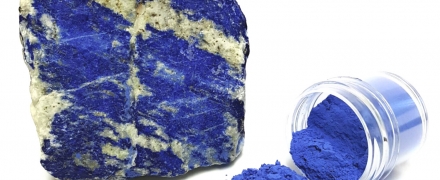open 10 am - 7 pm
laboratory is closed
Colorful gems

Many opaque gemstones are prized for their vibrant color, and for some, the color is so prized that even dust is used. Dust and crumbs of gems such as lapis lazuli, malachite, azurite were so valuable that they were collected and sold to make paints. Of course, for the manufacture of paints such minerals as realgar, orpiment, cinnabar, antimonite, barite, hematite, limonite and others were also used, but paints from gems were valued above all. And although in our time chemical technologies have been developed that make it possible to produce dyes with the most incredible and bizarre colors and shades, mineral pigments continue to be in steady demand. It is difficult to imagine restorers and artists without them. Often, many of them work with paints made using traditional technologies. In addition to powders, colored stones can also be found in monumental works of architecture and painting in the form of separate pieces of mosaics. These traditions of color rendering are rooted in the distant past. I would especially like to highlight the mosaic technique, which was formed in Italian Florence in the 16th century. This type of selection of stones in shape, color and texture made it possible to compose paintings from them, replacing brush strokes or whole colorful spots with separate elements.
В геммологической практике бывают весьма увлекательные случаи с диагностикой ювелирных вставок
Но помимо редкости цвета и высокой стоимости таких камней, многие розовые камни выделяются одной замечательной особенностью – они проявляют плеохроизм, то есть в зависимости от положения осмотра камня он может иметь дополнительные оттенки – оранжевый или пурпурный.
Currently, gemstones are produced by two fundamentally different technological methods - the High Pressure - High Temperature method (“HPHT”, High-pressure & High-temperature) and the Chemical Vapor Deposition (“CVD”, Chemical vapor deposition) method. The "HPHT" method is the most tested classical synthesis method, which can be used both carbon deposition on diamond from flux melts and catalytic reactions. In "CVD" synthesis, diamond growth occurs on a seed during carbon deposition mainly from a gaseous medium at relatively low temperatures and pressures.
Jewelry and precious stones are just such a category of goods, when buying which you need to pay attention to many criteria.
Sogdianite is a rather rare mineral and more often it can be found as a collection material (moreover, in systematic collections), and it is extremely rare in jewelry.






